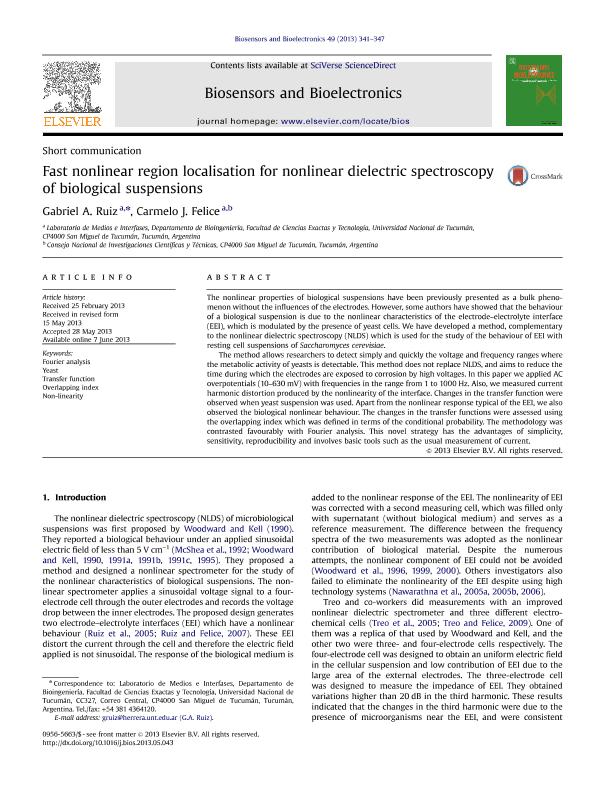Mostrar el registro sencillo del ítem
dc.contributor.author
Ruiz, Gabriel Alfredo

dc.contributor.author
Felice, Carmelo Jose

dc.date.available
2017-08-07T20:45:55Z
dc.date.issued
2013-06
dc.identifier.citation
Ruiz, Gabriel Alfredo; Felice, Carmelo Jose; Fast nonlinear region localisation for nonlinear dielectric spectroscopy of biological suspensions; Elsevier Science; Biosensors & Bioelectronics; 49; 6-2013; 341-347
dc.identifier.issn
0956-5663
dc.identifier.uri
http://hdl.handle.net/11336/21991
dc.description.abstract
The nonlinear properties of biological suspensions have been previously presented as a bulk phenomenon without the influences of the electrodes. However, some authors have showed that the behaviour of a biological suspension is due to the nonlinear characteristics of the electrode–electrolyte interface (EEI), which is modulated by the presence of yeast cells. We have developed a method, complementary to the nonlinear dielectric spectroscopy (NLDS) which is used for the study of the behaviour of EEI with resting cell suspensions of Saccharomyces cerevisiae. The method allows researchers to detect simply and quickly the voltage and frequency ranges where the metabolic activity of yeasts is detectable. This method does not replace NLDS, and aims to reduce the time during which the electrodes are exposed to corrosion by high voltages. In this paper we applied AC overpotentials (10–630 mV) with frequencies in the range from 1 to 1000 Hz. Also, we measured current harmonic distortion produced by the nonlinearity of the interface. Changes in the transfer function were observed when yeast suspension was used. Apart from the nonlinear response typical of the EEI, we also observed the biological nonlinear behaviour. The changes in the transfer functions were assessed using the overlapping index which was defined in terms of the conditional probability. The methodology was contrasted favourably with Fourier analysis. This novel strategy has the advantages of simplicity, sensitivity, reproducibility and involves basic tools such as the usual measurement of current.
dc.format
application/pdf
dc.language.iso
eng
dc.publisher
Elsevier Science

dc.rights
info:eu-repo/semantics/openAccess
dc.rights.uri
https://creativecommons.org/licenses/by-nc-nd/2.5/ar/
dc.subject
Yeast
dc.subject
Impedance
dc.subject
Non-Linear
dc.subject
Algorithm
dc.title
Fast nonlinear region localisation for nonlinear dielectric spectroscopy of biological suspensions
dc.type
info:eu-repo/semantics/article
dc.type
info:ar-repo/semantics/artículo
dc.type
info:eu-repo/semantics/publishedVersion
dc.date.updated
2017-08-07T17:37:34Z
dc.journal.volume
49
dc.journal.pagination
341-347
dc.journal.pais
Países Bajos

dc.journal.ciudad
Amsterdam
dc.description.fil
Fil: Ruiz, Gabriel Alfredo. Universidad Nacional de Tucuman. Facultad de Ciencias Exactas y Tecnología. Departamento de Bioingeniería. Laboratorio de Medios e Interfases; Argentina. Consejo Nacional de Investigaciones Científicas y Técnicas; Argentina
dc.description.fil
Fil: Felice, Carmelo Jose. Universidad Nacional de Tucuman. Facultad de Ciencias Exactas y Tecnología. Departamento de Bioingeniería. Laboratorio de Medios e Interfases; Argentina. Consejo Nacional de Investigaciones Científicas y Técnicas; Argentina
dc.journal.title
Biosensors & Bioelectronics

dc.relation.alternativeid
info:eu-repo/semantics/altIdentifier/doi/http://dx.doi.org/10.1016/j.bios.2013.05.043
dc.relation.alternativeid
info:eu-repo/semantics/altIdentifier/url/http://www.sciencedirect.com/science/article/pii/S0956566313003771
Archivos asociados
